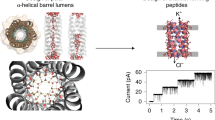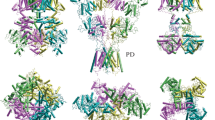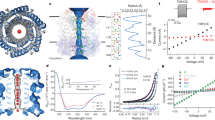Abstract
Peptaibols are considered as models of those ion channels which consist of a bundle of transbilayer helices surrounding a central pore. X-Ray diffraction and NMR studies have yielded high resolution structures for several peptaibols. In conjunction with other spectroscopic investigations and molecular dynamics simulations, these studies suggest that peptaibols form proline-kinked α-helices, and that there may be “hinge-bending” movement of the helix in the region of the central proline residue. The amphipathicity of peptaibol helices is analyzed in relation to their channel-forming properties. Studies of the interactions of peptaibols with lipid bilayers suggest that they are helical when in a membrane-like environment, and that the helix orientation relative to the bilayer is sensitive to the peptaibol: lipid ratio, and to the degree of hydration of the bilayer. Electrical studies reveal that many peptaibols form multiple-conductance level channels in a voltage-dependent fashion. Analysis of conductance levels provides support for the “barrel stave” model of channel formation, whereby different conductance levels correspond to different numbers of monomers in a helix bundle. Alternative models for voltage-activation are discussed, and the roles of molecular dipoles and of hinge-bending in this process are considered. Two molecular models for an N = 6 bundle of alamethicin helices are presented and their electrostatic properties analyzed. The relevance of studies of peptaibols to channel and transport proteins in general is considered.
Similar content being viewed by others
Abbreviations
- Aib:
-
α-amino-isobutyric acid
- Alm:
-
alamethicin
- ATR-FTIR:
-
attenuated total reflection Fourier transform infrared
- CD:
-
circular dichroism
- CFP:
-
channel-forming peptide
- Chol:
-
cholesterol
- diPhyPC:
-
diphytanoyl phosphatidylcholine
- DMPC:
-
dimyristoyl phosphatidylcholine
- DOPC:
-
dioleoyl phosphatidylcholine
- DOPE:
-
dioleoyl phosphatidylethanolamine
- DPPS:
-
dipahnitoyl phosphatidylserine
- DTPC:
-
ditetradecyl phosphatidylcholine
- HSM:
-
hydrophilic surface map
- I-V:
-
current-voltage
- MLV:
-
multilamellar vesicle
- nAChR:
-
nicotinic acetylcholine receptor
- P:L:
-
protein-to-lipid ratio
- POPC:
-
palmitoyloleoyl phosphatidylcholine
- SUV:
-
small unilamellar vesicle
- Zrv:
-
zervamicin
References
Aléman C, Subirana JA, Perez JJ (1992) A molecular mechanical study of the structure of poly(α-aminoisobutyric acid). Biopolymers 32:621–631
Aqvist J, Warshel A (1989) Energetics of ion permeation through membrane channels: solvation of Na+ by gramicidin A. Biophys J 56:171–182
Archer SH, Cafiso DS (1991) Voltage-dependent conductance for alamethicin in phospholipid vesicles: a test for the mechanism of gating. Biophys J 60:380–388
Archer SJ, Ellena JF, Cafiso DS (1991) Dynamics and aggregation of the peptide ion channel alamethicin: measurement using spin-labeled peptides. Biophys J 60:389–398
Balaram P (1992) Non-standard amino acids in peptide design and protein engineering. Curr Opin Struct Biol 2:845–851
Balaram P, Sukumar M, Krishna K, Mellor IR, Sansom MSP (1992) The properties of ion channels formed by zervamicins. Eur Biophys J 21:117–128
Balasubramanian TM, Kendrick NCE, Taylor M, Marshall GR, Hall JE, Vodyanoy I, Reusser F (1981) Synthesis and characterisation of the major component of alamethicin. J Am Chem Soc 103:6127–6132
Ball FG, Sansom MSP (1989) Single channel gating mechanisms: model identification and parameter estimation. Proc R See London Ser B 236:385–416
Banerjee U, Tsui FP, Balasubramanian TN, Marshall GR, Chan SI (1983) Structure of alamethicin in solution: one- and two-dimensional 1H NMR studies at 500 MHz. J Mol Biol 165:757–775
Banerjee U, Zidovetski R, Birge RR, Chan SI (1985) Interaction of alamethicin with lecithin bilayers: a 31P and 2H NMR study. Biochemistry 24:7621–7627
Barlow DJ, Thornton JM (1988) Helix geometry in proteins. J Mol Biol 201:601–619
Baumann G, Mueller P (1974) A molecular model of membrane excitability. J Supramol Struct 2:538–557
Bogusz S, Boxer A, Busath DD (1992) An SS1-SS2 β-barrel structure for the voltage-activated potassium channel. Prot Eng 5:285–293
Boheim G (1974) Statistical analysis of alamethicin channels in black lipid membranes. J Membr Biol 19:277–303
Boheim G, Hanke W, Jung G (1983) Alamethicin pore formation: voltage-dependent flip-flop of α-helix dipoles. Biophys Struct Mech 9:181–191
Boheim G, Gelfert S, Jung G, Menestrina G (1987) α-Helical ion channels reconstituted into planar bilayers. In: Yagi K, Pullman B (eds) Ion transport through membranes. Academic Press, Tokyo, pp 131–145
Brumfeld V, Miller IR (1990) Electric field dependence of alamethicin channels. Biochim Biophys Acta 1024:49–53
Burgess AW, Leach SJ (1973) An obligatory alpha-helical amino acid residue. Biopolymers 12:2599–2605
Cascio M, Wallace BA (1988) Conformation of alamethicin in phospholipid vesicles: implications for insertion models. Proteins: Struct Funct Genet 4:89–98
Cowan SW, Schirmer T, Rummel G, Steiert M, Ghosh R, Pauptit RA, Jansonius JN, Rosenbusch JP (1992) Crystal structures explain functional properties of two E. coli porins. Nature 358:727–733
Davis ME, Madura JD, Luty BA, McCammon JA (1991) Electrostatics and diffusion of molecules in solution: simulations with the University of Houston Brownian Dynamics program. Comp Phys Commun 62:182–197
Dempsey CE (1990) The actions of melittin on membranes. Biochim Biophys Acta 1031:143–161
Dempsey CE, Bazzo R, Harvey TS, Syperek I, Boheim G, Campbell ID (1991) Contribution of proline-14 to the structure and actions of melittin. FEBS Lett 281:240–244
Duclohier H, Molle G, Spach G (1989) The influence of the trichozianin C-terminal residues on the ion channel conductance in lipid bilayers. Biochim Biophys Acta 987:133–136
Duclohier H, Molle G, Dugast JY, Spach G (1992) Prolines are not essential residues in the “barrel-stave” model for ion channels induced by alamethicin analogues. Biophys J 63:868–873
Durrell SR, Guy HR (1992) Atomic scale structure and functional models of voltage-gated potassium channels. Biophys J 62:238–250
Edmonds DT (1989) A kinetic role for ionizable sites in membrane channel proteins. Eur Biophys J 17:113–119
Esposito G, Carver JA, Boyd J, Campbell ID (1987) High resolution 1H NMR study of the solution structure of alamethicin. Biochemistry 26:1043–1050
Fox RO, Richards FM (1982) A voltage-gated ion channel model inferred from the crystal structure of alamethicin at 1.5 Å resolution. Nature 300:325–330
Fraternali F (1990) Restrained and unrestrained molecular dynamics simulations in the NVT ensemble of alamethicin. Biopolymers 30:1083–1099
Frey S, Tamm LK (1991) Orientation of melittin in phospholipid bilayers: a polarized attenuated total reflection infrared study. Biophys J 60:922–930
Furois-Corbin S, Pullman A (1988) Conformation and pairing properties of the N-terminal fragments of trichorzianine and alamethicin: a theoretical study. Biochim Biophys Acta 944:399–413
Gordon LGM, Hayden DA (1972) The unit conductance channel of alamethicin. Biochim Biophys Acta 255:1014–1018
Gordon LGM, Haydon DA (1975) Potential-dependent conductances in lipid membranes containing alamethicin. Philos Trans R See London B 270:433–447
Hall JE, Vodyanoy I, Balasubramanian TM, Marshall GR (1984) Alamethicin: a rich model for channel behaviour. Biophys J 45:233–247
Hanke W, Boheim G (1980) The lowest conductance state of the alamethicin pore. Biochim Biophys Acta 596:456–462
Hanke W, Methfessel C, Wilmsen HU, Katz E, Jung G, Boheim G (1983) Melittin and a chemically modified trichotoxin form alamethicin-type multi-state pores. Biochim Biophys Acta 727:108–114
Haris PI, Chapman D (1988) Fourier transform infrared spectra of the polypeptide alamethicin and a possible structural similarity with bacteriorhodopsin. Biochim Biophys Acta 943:375–380
Harvey SC (1989) Treatment of electrostatic effects in macromolecular modelling. Proteins: Struct Funct Genet 5:78–92
Hille B (1992) Ionic channels of excitable membranes (2nd edn). Sinauer Associates, Sunderland, Mass
Henderson R, Baldwin JM, Ceska TA, Zemlin F, Beckmann E, Downing KH (1990) Model for the structure of bacteriorhodopsin based on high-resolution electron cryo-microscopy. J Mol Biol 213:899–929
Hol WG, Duijen PT von, Berendsen HJC (1978) The α-helix dipole and the properties of proteins. Nature 273:443–446
Hol WGL (1985) Effects of the α-helix dipole upon the functioning and structures of proteins and peptides. Adv Biophys 19:133–165
Hol WGL, Halie LM, Sander C (1981) Dipoles of the α-helix and \-sheet: their role in protein folding. Nature 294:532–536
Huang HW, Wu Y (1991) Lipid-alamethicin interactions influence alamethicin orientation. Biophys J 60:1079–1087
Kaback HR, Bibi E, Roepe PD (1990) β-Galactosidase transport in E. coli: a functional dissection of the lac permease. TIBS 15:309–314
Karle IL (1992) Folding, aggregation and molecular recognition in peptides. Acta Crystallogr B 48:341–356
Karle IL, Balaram P (1990) Structural characteristics of α-helical peptide molecules containing Aib residues. Biochemistry 29:6747–6756
Karle IL, Flippen-Andersen J, Sukumar M, Balaram P (1987) Conformation of a 16-residue zervamicin IIA analog peptide containing 3 different structural features: 310-helix, α-helix and \-bend ribbon. Proc Natl Acad Sci, USA 84:5087–5091
Karle IL, Flippen-Andersen J, Agarwalla S, Balaram P (1991) Crystal structure of Leu-zervamicin, a membrane ion channel peptide. Implications for gating mechanisms. Proc Natl Acad Sci, USA 88:5307–5311
Karle IL, Flippen-Andersen J, Agarwalla S, Balaram P (1992) Implications for a ion channel in Leu-zervamicin. In: Sarma RH, Sarma MH (eds) Crystal structure of polymorph B. Structure and Function. Vol 2 Proteins, New York, Academic Press
Kelsh LP, Ellena JP, Cafiso DS (1992) Determination of the molecular dynamics of alamethicin using 13C NMR: implications for the mechanism of gating of a voltage-dependent channel. Biochimistry 31:5136–5144
Latorre R, Alvarez O (1981) Voltage-dependent channels in planar lipid bilayer membranes. Physiol Rev 61:77–150
Lear JD, Wasserman ZR, DeGrado WF (1988) Synthetic amphiphilic peptide models for protein ion channels. Science 240:1177–1181
LeBars M, Bachet B, Mornon JP (1988) Structure of a helical 19 peptide (trichorzianine AIIIC). Modelling of transmembrane channels. Z Kristallogr 185:588 (abstract)
Li J, Carroll J, Ellar DJ (1991) Crystal structure of insecticidal σ-endotoxin from Bacillus thuringiensis at 2.5 Å resolution. Nature 353:815–821
Marger MD, Saier MH (1993) A major superfamily of transmembrane facilitators that catalyse uniport, symport and antiport. TIBS 18:13–20
Marshall GD, Hodgkin EE, Langs DA, Smith GD, Zabrocki J, Leplawy MT (1990) Factors governing helical preference of peptides containing multiple α,α-dialkyl amino acids. Proc Natl Acad Sci, USA 87:487–491
Mathew MK, Balaram P (1983a) A helix dipole model for alamethicin and related transmembrane channels. FEBS Lett 157:1–5
Mathew MK, Balaram P (1983b) Alamethicin and related channel forming polypeptides. Mol Cell Biochem 50:47–64
Mellor IR, Sansom MSP (1990) Ion channel properties of mastoparan, a 14 residue peptide from wasp venom, and of MP3, a 12 residue analogue. Proc R Soc London B 239:383–400
Mellor IR, Thomas DH, Sansom MSP (1988) Properties of ion channels formed by Staphylococcus aureus σ-toxin. Biochim Biophys Acta 942:280–294
Miller C (1992) Hunting for the pore of voltage-gated channels. Curr Biol 2:573–575
Molle G, Duclohier H, Spach G (1987) Voltage-dependent and multi-state ionic channels induced by trichorzianines, anti-fungal peptides related to alamethicin. FEBS Lett 224:208–212
Molle G, Dugast JY, Duclohier H, Spach G (1988) Conductance properties of des-Aib-Leu-des-Pheol-Phe-alamethicin in planar lipid bilayers. Biochim Biophys Acta 938:310–314
Molle G, Duclohier H, Dugast JY, Spach G (1989) Design and conformation of non-Aib synthetic peptides enjoying alamethicin-like ionophore activity. Biopolymers 28:273–283
Molle G, Duclohier H, Julien S, Spach G (1991) Synthetic analogues of alamethicin: effect of C-terminal residue substitutions and chain length on the ion channel lifetimes. Biochim Biophys Acta 1064:365–369
Oiki S, Madison V, Mental M (1990) Bundles of amphipathic transmembrane α-helices as a structural motif for ion-conducting channel proteins: studies on sodium channels and acetylcholine receptors. Proteins: Struct Funct Genet 8:226–236
Padley RC, Cook JC, Rinehart KL (1977) High resolution and field desorption mass spectrometry studies and revised structures of alamethicins I and II. J Am Chem Soc 99:8469–8483
Parker MW, Pattus F, Tucker AD, Tsernoglou D (1989) Structure of the membrane-pore-forming fragment of colicin-A. Nature 337:93–96
Pastore A, Harvey TS, Dempsey CE, Campbell ID (1989) The dynamic properties of melittin in solution — investigation by NMR and molecular dynamics. Eur Biophys J 16:363–367
Rebuffat S, Prigent Y, Auvin-Guette C, Bodo B (1991) Tricholongins BI and BII, 19-residue peptaibols from Trichoderma longibrachiatum: solution structure from two-dimensional NMR spectroscopy. Eur J Biochem 210:661–674
Richardson JS, Richardson DC (1989) Principles and patterns of protein conformation. In: Fasman GD (ed) Prediction of protein structure and the principles of protein conformation, Plenum, New York, pp 1–98
Rizzo V, Stankowski S, Schwarz G (1987) Alamethicin incorporation in lipid bilayers: a thermodynamic analysis. Biochemistry 26:2751–2759
Sankararamakrishnan R, Vishveshwara S (1992) Geometry of proline-containing alpha-helices in proteins. Int J Peptide Protein Res 39:356–363
Sankararamakrishnan R, Vishveshwara S (1993) Characterisation of proline-containing α-helix (helix F model of bacteriorhodopsin) by molecular dynamics studies. Proteins: Struct Funct Genet 15:26–41
Sansom MSP (1991) The biophysics of peptide models of ion channels. Prog Biophys Mol Biol 55:139–236
Sansom MSP (1992) An investigation of the role of serine and threonine sidechains in ion channel proteins. Eur Biophys J 21:281–298
Sansom MSP (1993) Peering down a pore. Curr Biol 3:239–241
Sansom MSP, Kerr ID (1993) Influenza virus M2 protein: a molecular modelling study of the ion channel. Prot Eng 6:65–74
Sansom MSP, Kerr ID, Mellor IR (1991) Ion channels formed by amphipathic helical peptides—a molecular modelling study. Eur Biophys J 20:229–240
Sansom MSP, Balaram P, Karle IL (1993) Molecular modelling of ion channels formed by zervamicin-IIB. Eur Biophys J 21:369–383
Schwarz G (1987) Basic kinetics of binding and incorporation with supramolecular aggregates. Biophys Chem 26:163–169
Schwarz G, Savko P (1982a) Dielectric probe of the electric-field-sensitive peptide alamethicin. Bioelectromagnetics 3:25–28
Schwarz G, Savko P (1982b) Structural and dipolar properties of the voltage-dependent pore former alamethicin in octanol/dioxane. Biophys J 39:211–219
Schwarz G, Savko P, Jung G (1983) Solvent-dependent structural features of the membrane active peptide trichotoxin A40 as reflected in its dielectric dispersion. Biochim Biophys Acta 728:419–428
Schwarz G, Stankowski S, Rizzo V (1986) Thermodynamic analysis of incorporation and aggregation in a membrane: application to the pore-forming peptide alamethicin. Biochim Biophys Acta 861:141–151
Schwarz G, Gerke H, Rizzo V, Stankowski S (1987) Incorporation kinetics in a membrane, studied with the pore-forming peptide alamethicin. Biophys J 52:685–692
Stankowski S, Schwarz G (1989) Lipid dependence of peptide-membrane interactions: bilayer affinity and aggregation of the peptide alamethicin. FEBS Lett 250:556–560
Stankowski S, Schwarz UD, Schwarz G (1988) Voltage-dependent pore activity of the peptide alamethicin correlated with incorporation in the membrane: salt and cholesterol effects. Biochim Biophys Acta 941:11–18
Stroud RM, McCarthy MP, Shuster M (1990) Nicotinic acetylcholine receptor superfamily of ligand gated ion channels. Biochemistry 29:1107–1123
Toniolo C, Benedetti E (1991) The polypeptide 310-helix. Trends Biochem Sci 16:350–353
Toyoshima C, Unwin N (1988) Ion channel of acetylcholine receptor reconstructed from images of post-synaptic membranes. Nature 336:247–250
Unwin N (1989) The structure of ion channels in membranes of excitable cells. Neuron 3:665–676
Unwin N (1993) Nicotinic acetylcholine receptor at 9 Å resolution. J Mol Biol 230:1101–1124
Vodyanoy I, Hall JE, Balasubramanian TM (1983) Alamethicininduced current-voltage curve asymmetry in lipid bilayers. Biophys J 42:71–82
Vogel H (1987) Comparison of the conformation and orientation of alamethicin and melittin in lipid membranes. Biochemistry 26:4562–4572
Wada A (1976) The α-helix as an electric macro-dipole. Adv Biophys 9:1–63
Weiss MS, Kreusch A, Schiltz E, Nestel U, Welte W, Weckesser J, Schulz GE (1991) The structure of porin from Rhodobacter capsulatus at 1.8 Å resolution. FEBS Lett 280:379–382
Wine JJ (1993) Ion channels and transmembrane transporters. Curr Biol 3:118–120
Woolley GA, Wallace BA (1992) Model ion channels: gramicidin and alamethicin. J Membr Biol 129:109–136
Woolley GA, Wallace BA (1993) Temperature-dependence of the interaction of alamethicin helices in membranes. (submitted for publication)
Yee AA, O'Neil JDJ (1992) Uniform 15N labeling of a fungal peptide: the structure and dynamics of an alamethicin by 15N and 1H NMR spectroscopy. Biochemistry 31:3135–3143
Author information
Authors and Affiliations
Rights and permissions
About this article
Cite this article
Sansom, M.S.P. Alamethicin and related peptaibols — model ion channels. Eur Biophys J 22, 105–124 (1993). https://doi.org/10.1007/BF00196915
Received:
Accepted:
Issue Date:
DOI: https://doi.org/10.1007/BF00196915




